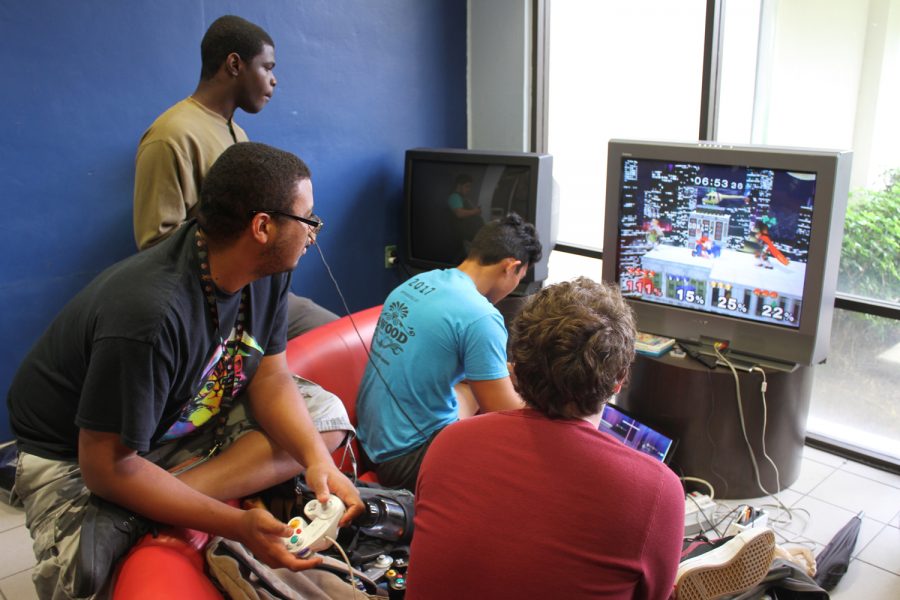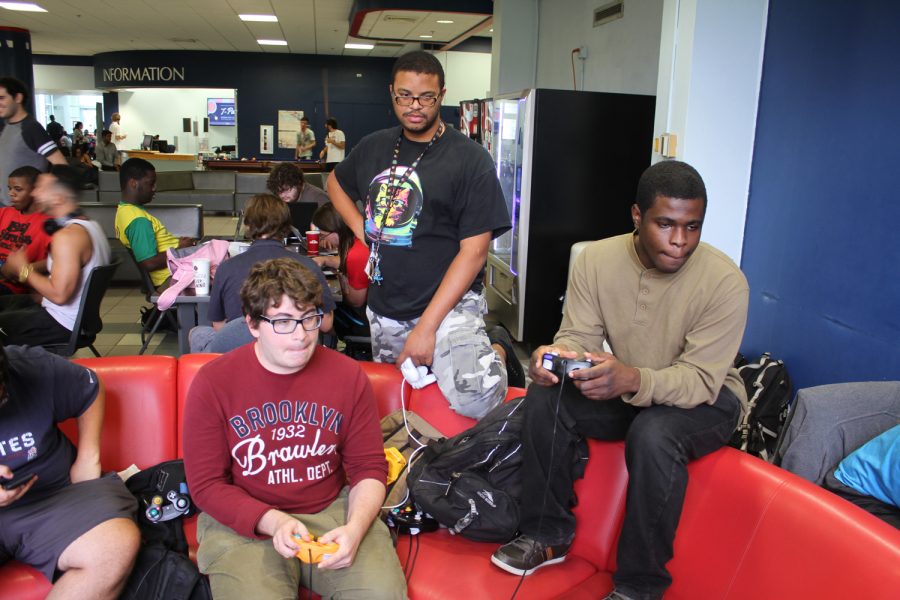Students train to make it in the competitive video gaming scene
FAU’s College Gaming League takes competitive gaming seriously — but what does it really take to play video games for a living?
Students practice their Super Smash Bros. skills in the Student Union. Thomas Chiles | Features Editor
November 30, 2017
Playing video games all day sounds easy enough — but what’s not easy is making it to the professional level.
The spread of competitive gaming is apparent now that popular video game tournaments are broadcasted on major cable networks like TBS and ESPN. And students who love video games are working hard in the hopes of turning their hobby into a full-time job.
FAU’s College Gaming League, founded in 2008, is a club where student gamers gather to practice their video game skills. They meet in IVA South every Friday at 7 p.m., but throughout the school week you can find many club members near the row of TVs in the Student Union.
“It started out as a casual thing, and the last two or three years it has become more competitive,” CGL Vice President Jonathan Carberry said.
Many of the students at the club, like Carberry, are there to get better at whatever game they’re practicing. Released in 2001, “Super Smash Bros. Melee” continues to be one of the most popular games played on campus.

Carberry said his goal is to become the best “Super Smash Bros. Melee” player in the world — and he feels like he’s on his way.
“Keeping it up is like playing a musical instrument,” the junior computer science major said. “You have to practice consistently and practice specific things.”
But as easy as it may seem to an outsider, becoming a professional gamer takes a lot of time and practice, and it usually begins at a young age.
A Shifting Culture
Competitive gaming, or eSports, is comparable to traditional sports in many ways. For example, if you start training at a young age, the potential to go professional is significantly increased.
One problem young American gamers may face is that many parents today frown upon their child playing video games for extended periods of time. They may even discourage the pursuit of professional gaming altogether.
“A big issue is definitely parental support,” CGL President Ricardo Bolanos said. “More often than not, young players rely on their parents for transportation and if the support is not there then they just can’t do it.”
At first, Carberry said his parents didn’t realize his potential as a competitive gamer.
“I don’t think my parents believed that I could be the best, even in South Florida, until I actually brought home money,” Carberry said.
Carberry plays and wins money in local tournaments hosted at Versus Gaming Center, located in Pompano Beach.
Even if gamers aren’t reliant on their parents for support, there is still a stigma in the U.S. surrounding people who take video games seriously.
“When Super Smash Bros. was on TV, there were so many tweets from people complaining about a video game being on ESPN,” mechanical engineering major Bolanos said.
But as eSports continues to blossom, Bolanos hopes the general public will become more open to the idea of competitive gaming.
Practice, Practice, Practice
Garen Mazmanian has been playing “Super Smash Bros. Melee” since he was 6 years old.
“Ever since I first played it something magical happened, as cliché as it sounds, I just loved the game,” Mazmanian said.
Mazmanian, 23, is now one of the top ranked Melee players in the area. Although he graduated from FAU with an associate degree in computer science a few years ago, he still shows up at the Student Union and CGL meetings from time to time to get in some practice.
“In South Florida right now I’m ranked about fourth to seventh, somewhere like that,” Mazmanian said. “But I don’t really want to stop here, my goal as a competitor is to be the best. Right now, I’m just not pleased, I don’t check [my ranking] because I’m just disgusted when I look at it.”
Mazmanian has been gaming competitively for the last four years, and he believes that a large factor in keeping your gaming skills sharp is connected to your mindset and mentality.
“Realistically, you just have to play as much as possible and enjoy learning,” he said. “Either you win or learn, there is no losing.”
CGL member Darlington Igwenagu explained how important consistent practice is for pro gamers.
“The top Smash players have been playing for over 10 years, and practice many, many hours,” the sophomore multimedia media studies major said. “They watch videos of themselves and other top players to study.”
So how many hours does one have to practice to become a pro? While everybody is different, Joemar Celcis, another CGL member, said the “10,000 hour rule” is applicable to many games.
“In order for someone to achieve mastery over something, 10,000 hours is the minimum to fully understand it,” Celcis said, a junior management information systems major. “That’s how long musicians practiced since they were young to become masters of their instruments.”
He added that there aren’t casual players who just stumbled into the competitive scene without trying, saying that becoming a professional gamer takes over your life.
“Obviously [pros] love the game but it’s a job,” said Celcis. “You play the game to practice and win, and that changes your mentality a lot.”
Carberry, the club’s vice president, knows how vital every hour of practice can be.
“I used to play a whole lot, about eight to 10 hours a day,” Carberry said.
But it wasn’t long before he began feeling pain shooting through his hand when he played.
No Pain, No Gain
A trip to the doctor revealed that Carberry had developed tendinitis from practicing too much. The doctor told him to take it easy when handling the game controller.
Now, he takes precautions each time he sits down to game.
“Everytime before I play I stretch my hands, just keep everything loose to make sure it doesn’t happen again,” Carberry said.
When Carberry goes to tournaments, he plays for hours on end — so he was forced to get innovative when dealing with hand pain.
“Sometimes in specific fingers I feel pain, so I’ve trained myself to switch between different controller grip styles,” said Carberry.
Some professional gamers have developed chronic hand pain due to excessive playing. One pro even went as far as building his own custom controller to relieve stress on his hands.
So when Mazmanian practices, he makes sure not to overdo it.
“Sometimes I play about three to four days in a row, and I have to take weeks off at a time to relax my hands and get out of bad mindsets,” Mazmanian said. “It’s good to rest your hands and your mindset.”
Celcis said that eSports aren’t all that different from traditional sports like football and basketball.
“Just like regular sports, eSports requires you to commit to something and keep playing it,” Celcis said. “Yeah, you’re playing games, but you’re playing games to be better than everyone else.”
Thomas Chiles is the features editor of the University Press. For information regarding this or other stories, email tchiles2013@fau.edu.







The Power • Dec 4, 2017 at 6:55 pm
Competitive gaming is the future.